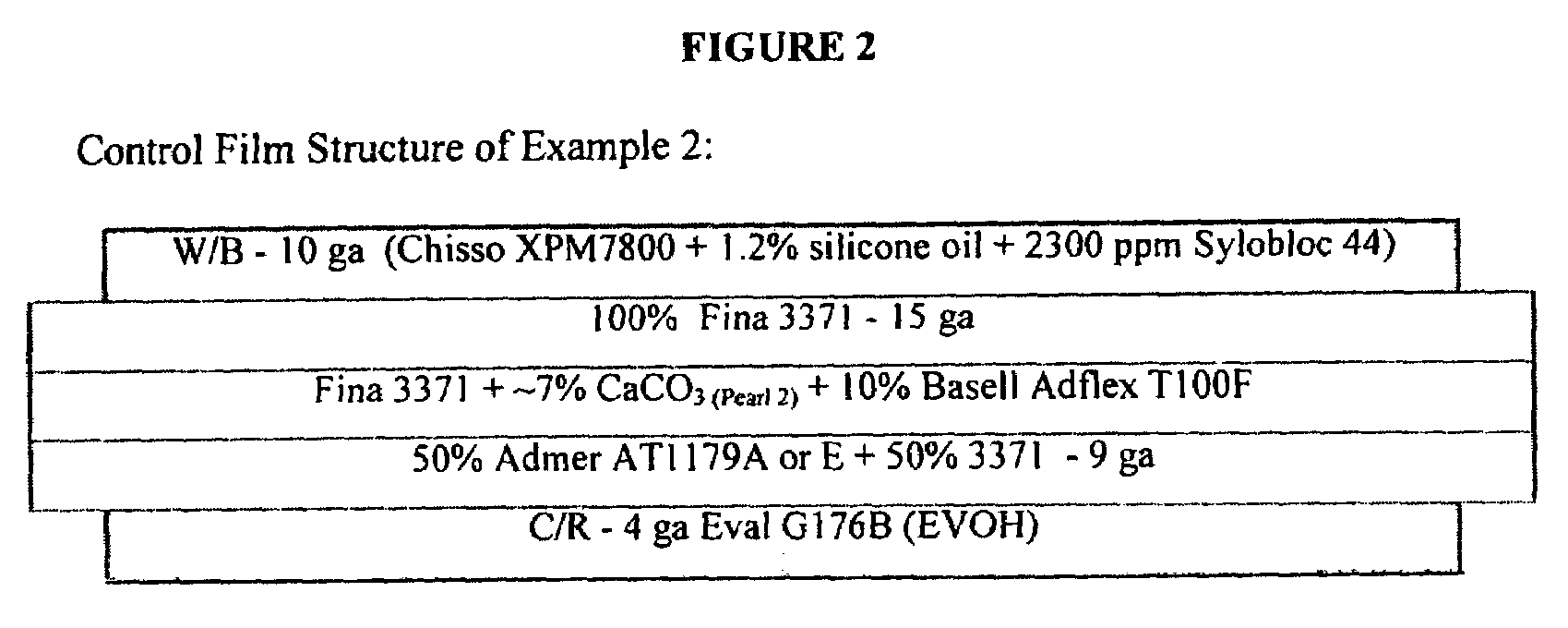Multi-layer films having improved sealing properties
a polymer film and sealing technology, applied in the field of heat sealing and multi-layer polymer films having improved sealing properties, can solve the problems of increasing the degree of entanglement and intermingling of adjacent layers, and achieve the effects of improving seal strength, impact strength, resilience, and hermeticity
- Summary
- Abstract
- Description
- Claims
- Application Information
AI Technical Summary
Benefits of technology
Problems solved by technology
Method used
Image
Examples
example 1
Control
[0110]An opaque, oriented, five-layer film having an A / B / C / D / E structure is prepared as a control film. The A layer is an outer skin layer (4 ga.) comprising an EVOH polymer (Eval G176B from Kuraray Company Ltd. of Japan). The B layer is a tie layer (12 ga.) comprising 50 weight percent of an adhesive resin (Admer AT1179A) and 50 weight percent of Fina 3371 isotactic polypropylene homopolymer resin (Fina 3371 from AtoFina Chemical). The C layer is a core layer comprising 90 weight percent of an isotactic polypropylene homopolymer (Fina 3371 from Fina Oil) and 10 weight percent PBT cavitating agent. The D layer is a tie layer (12 ga.) comprising 100 weight percent Fina 3371. The E layer is a sealant layer (5 ga.) comprising an EPB terpolymer (Chisso XPM7794 from Chisso Company). This film has a target polygauge thickness of 0.9 mil and a 1.1. mil target optical gauge and is illustrated in FIG. 1.
example 2
Control
[0111]An opaque, oriented, five-layer film having an A / B / C / D / E structure is prepared according to an embodiment of the present invention. The A layer is an outer skin layer (4 ga.) comprising an EVOH polymer (Eval G176B from Kuraray Company Ltd. of Japan). The B layer is a second tie layer (9 ga.) comprising 50 weight percent of an adhesive resin (Admer AT 1179A) and 50 weight percent of 3371 isotactic polypropylene homopolymer resin (Fina 3371 from AtoFina Chemical). The C layer is a core layer comprised of about 83 weight percent Fina 3371, 10 percent soft polymer (Adflex T100F “Cataloy™,” an EP copolymer having a relatively high elastomer content, from Basell Company), and 10 weight percent calcium carbonate. The D layer is a first tie layer (15 ga.) comprising 100 percent Fina 3371. The E layer is a sealant layer (10 ga.) comprising an EPB terpolymer (Chisso XPM7800 from Chisso Company) and 1.2 weight percent silicone oil (migratory slip agent) and 2300 ppmw of an anti-bl...
example 3
[0112]An opaque, oriented, five-layer film having an A / B / C / D / E structure, illustrated in FIG. 3, is prepared according to an embodiment of the present invention. The A layer is an outer skin layer (4 ga.) comprising Eval G176B (EVOH). The B layer is a tie layer (12 ga.) comprising 50 weight percent of an adhesive resin (Admer AT1179A, from Mitsui Polymers) and 50 weight percent of Fina 3371. The C layer is a core layer comprised of about 84 weight percent Exxon 4612 PP, about 10 weight percent Adflex T100F Catalloy™ EP copolymer, and about 6 weight percent calcium carbonate as a cavitating agent. The D layer is a tie layer (15 ga.) comprising 25 weight percent Exxon 4612 and 75 weight percent Basell Adflex T100F. The E layer is a sealant layer (10 ga.) comprising Chisso XPM7800 EPB terpolymer from Chisso Company, 1.2 weight percent silicone oil, and 2300 ppmw Sylobloc 44. This film has a 0.9 mil polygauge target and a 1.1 mil optical gauge target. Thus, the C layer (core layer) and ...
PUM
| Property | Measurement | Unit |
|---|---|---|
| Vicat softening point | aaaaa | aaaaa |
| seal temperature | aaaaa | aaaaa |
| pressure | aaaaa | aaaaa |
Abstract
Description
Claims
Application Information
 Login to View More
Login to View More - R&D
- Intellectual Property
- Life Sciences
- Materials
- Tech Scout
- Unparalleled Data Quality
- Higher Quality Content
- 60% Fewer Hallucinations
Browse by: Latest US Patents, China's latest patents, Technical Efficacy Thesaurus, Application Domain, Technology Topic, Popular Technical Reports.
© 2025 PatSnap. All rights reserved.Legal|Privacy policy|Modern Slavery Act Transparency Statement|Sitemap|About US| Contact US: help@patsnap.com



